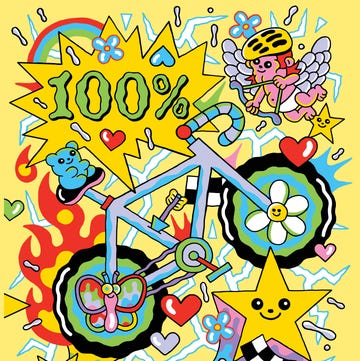“Perfection is achieved, not when there is nothing more to add, but when there is nothing left to take away.”
In recent months, engineers from two different cycling brands have referenced this quote during our discussions about new products. It comes from Antoine de Saint-Exupéry’s Airman’s Odyssey, though he is best known as the author of The Little Prince. (Saint-Exupéry, however, seems to be riffing on the Latin phrase entia non sunt multiplicanda praeter necessitatem, or “entities should not be multiplied beyond necessity.” This is a tidy encapsulation of the most famous work of William of Ockham: Occam’s razor.)
Like an earworm, Saint-Exupéry’s quote is stuck in my head. As I ride bikes and think about cycling equipment, it keeps rising to the fore. Ironically, both engineers used this quote to describe the underpinning philosophy of incredibly complex products: One was electronically controlled wireless suspension, the other a carbon full-suspension mountain bike.
Bicycles are simple: two wheels connected inline by a frame. From there, we’ve modified, evolved, tweaked, tuned—always adding more and more. So much has been added, in fact, that the market is now flooded with an overwhelming amount of equipment, technologies, and features. There is so much out there with so much overlap that browsing a bike shop or shopping online is an exercise of sensory assault.
I can find examples in any corner of cycling, but I’m going to use gravel bikes and equipment to highlight my complaints. Gravel is the “newest” cycling category (hilarious because the first bicycles were gravel bikes). These are drop-bar (though not exclusively) bikes primarily intended for use on nonpaved road surfaces.
Let’s look at Specialized’s gravel bike line. It consists of three families: the Crux, the Diverge, and the Diverge STR. (That’s leaving out the e-bikes.) The Crux is the most basic: round tubes, external routing, no odd standards, no proprietary anything. The Diverge’s standout feature is Specialized’s FutureShock rider-suspending system in the head tube. The Diverge STR has rider-suspending systems at the front and rear of the bike.
These three distinct bike families are all designed for gravel riding but, supposedly, serve the needs of different kinds of gravel riders. And each of those families has multiple builds and in some cases are offered in two different frame materials. On the Specialized site, as I write this, there are 33 different gravel bikes, each offered in multiple sizes and most in multiple colors (although some are previous-year-model holdovers).
Even though Specialized has so many different gravel bikes, I see an obvious hole in its gravel portfolio that I’m sure it will fill soon: a race bike with aerodynamic features like Trek’s Checkmate and Canyon’s Grail. I hope Specialized addresses this by updating its Crux model. However, the bike industry seemingly prefers to fix shortcomings by addition, so I fear Specialized will plug the hole by adding a fourth gravel model.
If asked about the many different gravel bikes, I presume Specialized would say it “listens to the riders” and was inspired by how it observes cyclists using its equipment. And I suspect it makes products it believes will sell.
But by selling so many bikes, does Specialized offer solutions or just add complexity that results in confusion for the rider? And let’s not forget that Specialized is but one brand: The total number of gravel bikes available from brands big and small is boggling. The bicycle comparison website, 99Spokes, lists, as I write this, about 7,800 gravel bikes (not including e-bikes) in its database.
It seems the bicycle industry, as much as it likes to shout out Saint-Exupéry and his Occam’s razor–inspired statement, agrees more with William of Ockham’s nemesis, Walter Chatton. Chatton rejected Occam’s philosophy of simplicity and instead pitched his anti-razor: “If three things are not enough to verify an affirmative proposition about things, a fourth must be added and so on.”
I understand that the basic tenets of capitalism are the rules of supply and demand; market competition forces the inferior to “innovate or die” (to use Specialized’s slogan) and allows the cream to rise. But when so many similar products flood the zone, I’d argue that chances increase of a buyer making an incorrect choice or finding themselves frustrated because they feel talked into features they don’t want. Or had no choice but to accept more bike than they need.
I have a role in this. It’s my job to review equipment and provide criticism and insight which, presumably, helps riders make a more informed choice. But with so many gravel bikes on the market, I can’t ride and review them all. It would be challenging for me just to ride and comprehensively review all of Specialized’s gravel options before it makes significant revisions to the line. And I don’t think there are enough cycling test editors on the planet to review all the gravel bikes available today.
I’m wise enough to know that some players welcome an information vacuum. It’s easier to sell a substandard bike to a rider who doesn’t know how a bike performs compared to the competition and what alternatives exist. But I believe the greater risk is buyers’ revolt: They get so overwhelmed by all the bikes that seem so alike, they’ll stick with what they know for fear of making the wrong choice. Or they recognize that piling on features they can’t or won’t use isn’t the same as providing a bike that offers performance and functionality.
So far, I’ve stuck to bikes, but there are endless cases in other gravel-oriented product categories: Panaracer’s 2024 GravelKing tire line consists of 17 different tires—each of which comes in several different widths and, in some cases, two diameters. POC’s website returns 27 results tagged “gravel helmet.” These are just two examples from one brand each (for the record, I don’t know what a gravel helmet is). Zoom out to the entire industry’s product offerings and the numbers increase exponentially. There are also gravel shoes, apparel, and, somehow, saddles. And this is just one small niche of cycling. I believe the world doesn’t need all this gravel-specific gear.
Here’s what I know about humans: We each have our own special interests. Consumerism has taught us to expect that not just our needs but also our desires are met down to a cellular level. At least some of the reason Specialized offers 33 different gravel bikes is its fear that if it doesn’t make a bike that’s W, X, and Y and also a bike that’s X, Y, and Z —largely similar but minutely different—customers will buy from the brand that does. So, I blame us as much as I blame them.
I’m not advocating that we all ride the same gravel bike and tire or wear the same helmet. I welcome choice and diversity when there is a purposeful distinction. But a purposeful distinction doesn’t come from coloring something matte khaki and calling it gravel. It doesn’t come from slicing a slice into more and thinner slices. Those actions only create confusion and waste, and cyclists don’t like those things.
I say the following with no expectation that anything will change, but I say it nevertheless: We all need to embrace the beauty and perfection of cycling’s simplicity.

A gear editor for his entire career, Matt’s journey to becoming a leading cycling tech journalist started in 1995, and he’s been at it ever since; likely riding more cycling equipment than anyone on the planet along the way. Previous to his time with Bicycling, Matt worked in bike shops as a service manager, mechanic, and sales person. Based in Durango, Colorado, he enjoys riding and testing any and all kinds of bikes, so you’re just as likely to see him on a road bike dressed in Lycra at a Tuesday night worlds ride as you are to find him dressed in a full face helmet and pads riding a bike park on an enduro bike. He doesn’t race often, but he’s game for anything; having entered road races, criteriums, trials competitions, dual slalom, downhill races, enduros, stage races, short track, time trials, and gran fondos. Next up on his to-do list: a multi day bikepacking trip, and an e-bike race.













